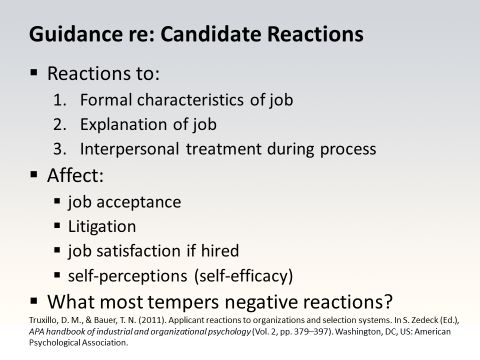Lecture Notes
I wanted to provide a bit of additional information beyond the textbook in regard to candidate reactions. There's a great chapter in the APA handbook of Industrial Organizational Psychology that carries reviews applicant reactions to selection systems. You can see the citation at the bottom of the slide. And so they talk about, there's really if a few major categories of what candidates react to. So the formal characteristics of jobs is the way that the jobs are explained to them and of course there's the inter personal treatment during the recruitment process that they are reacting to. We can break all of these down further, way the data cling together. So you've got these three categories of reactions and then there's effects depending on whether the reactions are positive or negative to each of these categories. And the effects that have been shown to relate are job acceptance, litigation, or lack there of, job satisfaction of hired, and individual's self-perceptions are self-efficacy, how well they think they will end up doing. Okay so what most tempers negative reactions you might ask? It's the job relatedness of measures and of the recruiting process, right? So it's important that along every step of the recruiting process you're thinking through: is what we're doing related to performance on the job? And if we're measuring or testing or selecting on anything that's not job related, it's certainly going to be more likely to drive negative candidate reactions and all the bad things that go along with that.
